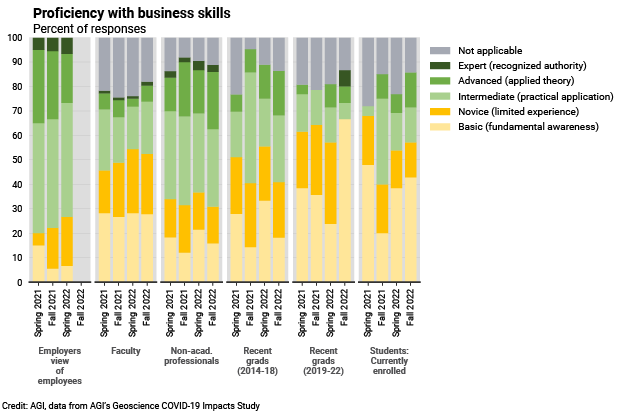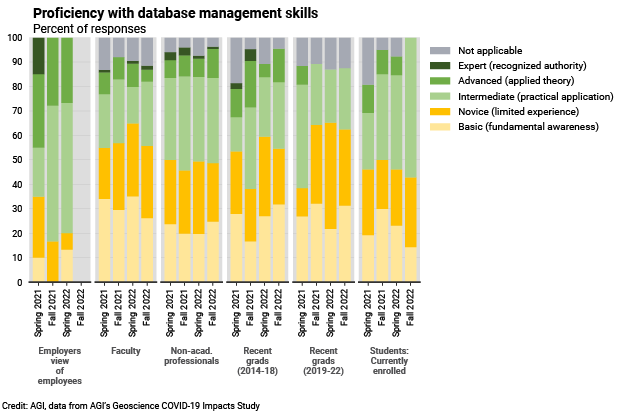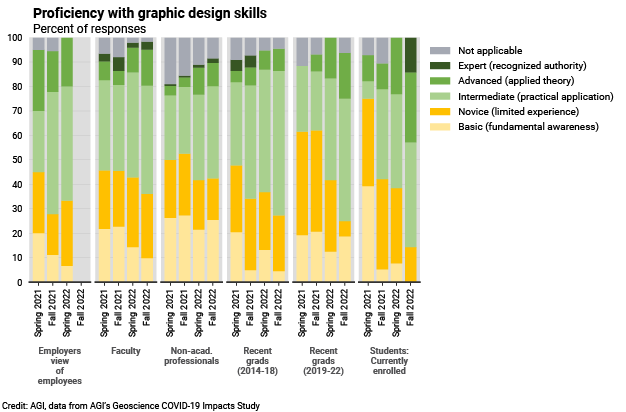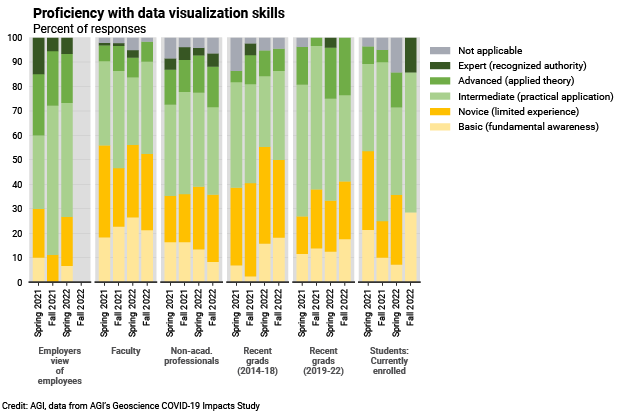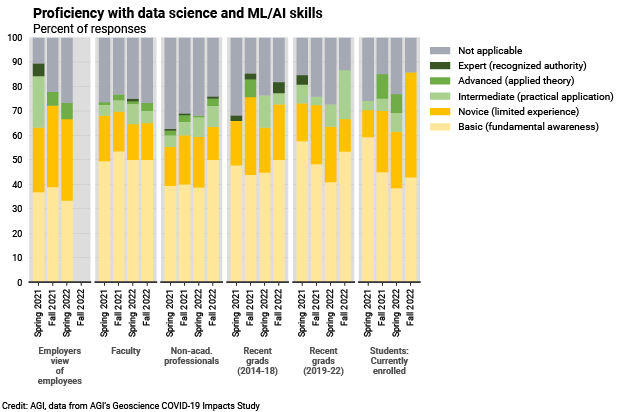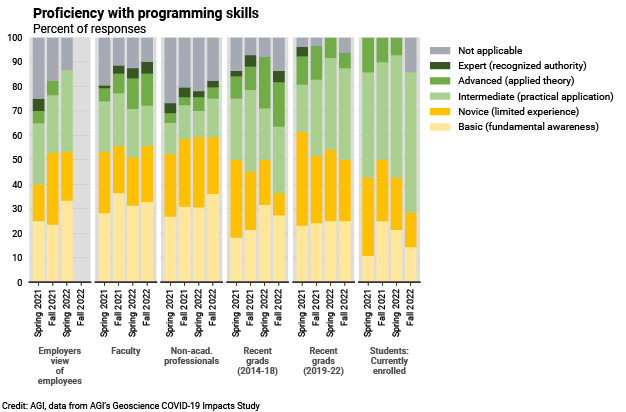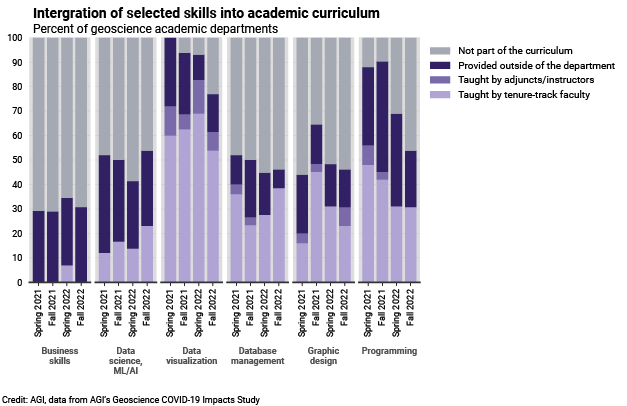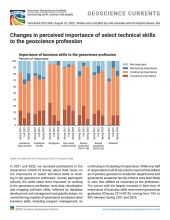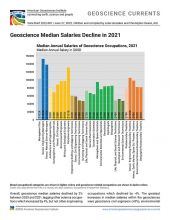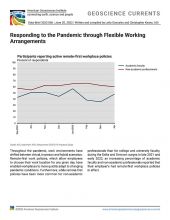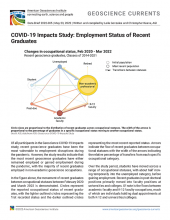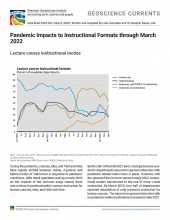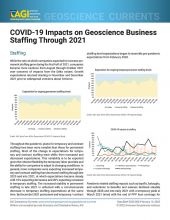In 2021 and 2022, the Geoscience COVID-19 Survey asked about the importance of and proficiency with select technical skills to working in the geoscience profession. In our previous data brief (DB-2022-008), we examined study participants’ views on the importance of these skills to the profession. In this data brief, we explore how study participants rated their proficiency with these skills and how these skills are being incorporated into geoscience academic programs. Note that the Fall 2022 surveys did not ask employers about employee skill proficiency.
Most employers reported at least intermediate proficiency among their employees with business skills; however, there was a decline in reported proficiency levels, likely indicating pandemic-era retirements and an influx of new graduates into the workforce. Among individual survey cohorts, academic faculty and students reported similar levels of proficiency with business skills, with just over half of participants reporting basic to novice proficiency. Interestingly, two-thirds of newly minted graduates (Classes 2019-2022) reported basic to novice level proficiency with business skills, whereas among recent graduates from Classes 2014-2018 there was an overall increase in business skill proficiency between Spring 2021 and Fall 2022, indicating that this skillset was developed with workforce experience. Non-academic professionals reported the highest levels of proficiency of all cohorts with over half of this cohort reporting intermediate to expert proficiency with this skillset.
Between Spring 2021 and Spring 2022, employers increasingly reported higher proficiency with database management skills among their employees. Among individual survey cohorts, academic faculty reported the lowest levels of proficiency with database management skills, with approximately one-third reporting at least intermediate proficiency. Students reported the largest growth in proficiency, with the percentage of students reporting at least intermediate proficiency increasing from 35% in Spring 2021 to 57% in Fall 2022. Recent graduates from the classes of 2014-2018 reported an overall increase in proficiency over the study period, with 41% of graduates reporting at least intermediate proficiency by Fall 2022. Approximately half of non-academic professionals reported intermediate to expert proficiency with database management, and this remained steady for the study period.
Employers reported increasing levels of proficiency among their employees with graphic design skills, with two-thirds of employers noting in Spring 2022 that their employees had at least intermediate proficiency. Among individual study cohorts, study participants across all cohorts reported increased proficiency with graphic design skills over the study period. Students had the largest gains in proficiency with 86% of students reporting at least intermediate proficiency in Fall 2022. Recent graduates also had large gains in proficiency with over two-thirds of both cohorts reporting at least intermediate proficiency in Fall 2022. Nearly half of non-academic professionals and two-thirds of faculty reported at least intermediate proficiency with this skillset in Fall 2022.
Employers consistently noted high proficiency among their employees with data visualization skills, including mapping software skills. Among individual cohorts, proficiency with data visualization skills among non-academic geoscientists and academic faculty remained high over the study period with over half of each cohort reporting intermediate to expert proficiency. Students reported increasing proficiency with this skillset, with 71% reporting at least intermediate proficiency by Fall 2022. Similar to other skillsets, newly minted graduates reported an increase in lower levels of proficiency with this skillset over the study period, likely reflecting the influx of new graduates into this cohort. Graduates from Classes 2014-2018 reported increasing proficiency at the basic to novice level, while higher levels of proficiency fluctuated slightly over the study period.
Data science skills, including machine learning (ML) and artificial intelligence (AI) are relatively new skillsets within the geoscience profession as indicated by the lower levels of proficiency across cohorts. The trends across cohorts suggest that the skillset is finding its application space within the geosciences as the strengths and limitations of ML and AI are being recognized. Over the course of the study, approximately two-thirds of employers reported that their employees had basic to novice proficiency with this skillset. It is interesting to note the increase in employers reporting that this skill was not applicable, from 11% in Spring 2021 to 27% in Spring 2022. Among individual cohorts, proficiency with data science skills remained relatively steady among academic faculty, with two-thirds reporting basic to novice proficiency. An increasing percentage of non-academic professionals and recent graduates from the Classes of 2014-2018 reported basic to novice proficiency over the study period (55% to 63% and 66% to 73%, respectively), with similar increases in those reporting intermediate to advanced proficiency. Approximately 70% of newly minted graduates reported basic to novice proficiency with data science, while an increasing percentage of students reported basic to novice proficiency over the study period (70% to 86%).
Employers increasingly reported that their employee’s proficiency with programming skills increased at the basic to novice level, while reported higher levels of proficiency remained steady near 33%. Among individual study cohorts, students reported the highest proficiency with programming skills, with over half of students reporting at least intermediate proficiency over the course of the study. Academic faculty reported slightly higher proficiency with programming than did non-academic professionals, with one-third of faculty reporting at least intermediate proficiency compared to nearly one-quarter of non-academic geoscientists. Among recent graduate cohorts, those in the Classes of 2014-2018 reported slightly higher proficiency with programming than newly minted graduates (50% vs. 44% with at least intermediate proficiency).
Incorporation of these select technical skills into academic programs varied by skillset. Business skills were incorporated by only 30% of academic departments, but almost exclusively taught outside of the department. Data science skills were included in about half of academic programs, but mostly taught outside of the department, although the percentage of departments reporting this skillset being taught by department faculty increased to 23% by Fall 2022. Data visualization skills were taught primarily by tenured faculty; however, there was a decline in departments reporting the incorporation of data visualization skills overall. By Fall 2022, nearly one-quarter of departments reported this skillset as not applicable and the percentage of departments reporting this skillset being taught by department faculty declined to 62%. Database management skills were incorporated by about half of departments and primarily taught by tenured faculty. Just under half of departments reported incorporating graphic design skills into their curriculum, with about 30% reporting this skillset being taught by department faculty. The percentage of departments reporting that programming was included in their curriculum declined to 54% by Fall 2022, with 31% of departments reporting this skillset being taught by department faculty and 23% reporting that it was offered outside of the department.
We will continue to provide current snapshots on the impacts of COVID-19 on the geoscience enterprise throughout the rest of this year. For more information about the study, please visit: www.americangeosciences.org/workforce/covid19
Funding for this project is provided by the National Science Foundation (Award #2029570). The results and interpretation of the survey are the views of the American Geosciences Institute and not those of the National Science Foundation.



